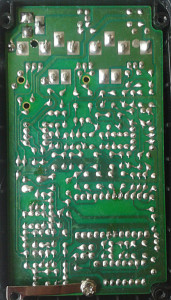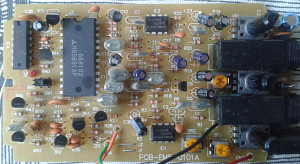What’s a better way to continue after DL5 than the other delay/echo from the same series…
What is it?
Ibanez EM5 Echomachine in plastic enclosure from later soundtank series. Made in taiwan around 1997-99.
The Internet Archive’s wayback machine has a snapshot of Ibanez site from june 1997 and on that page there is a mention the EM5 being the new and exciting pedal in the series of 18 different pedals Yes, 18. So it’s safe to assume that all the existing EM5s were manufactured in between 1996-1999, since all Soundtank production was taken over in 1999 by the next series – the Tone-Loks. In addition to those 18, the rest of the Soundtanks are in fact from the original, metal housed Soundtank series of six different dirt pedals. Namely PL5, TM5, CM5, SF5, CR5 and MF5. Only four of those made it to the plastic series as a continuation, the four being TM5, CM5, PL5 and SF5 (which had it’s model name revised to FZ5). So the latter Soundtank series produced 14 new designs to the bowl and it left out the super good Crunchy Rhythm and super bad Modern Fusion. Sort of like a ski jumping scores. You leave the best and the worst out.. All this should total at 20 different designs. Maybe i should write a Colorless Writings episode about soundtanks at one point. Or maybe even start a new writing series on history of some brands…
Ok. Let’s get back to business. The EM5 Echo Machine is a digital tape echo simulation delay/echo. I got this unit from the bass player of Versus All (huge thanks to Jason!) in perfect, nearly unused condition. Opening the bottom plate up shows your standard modern Soundtank traces. This time somewhat neater work on the joints than most other taiwanese Soundtanks. And the board is pretty crowded.
The digital chip responsible for the sounds is Mitsubishi M65831AP. Like many other Mitsubishi chips utilized by Ibanez, this one is too one of those you may find in many karaoke devices. The dual opamps used for buffering and mixing are C4570C, which are not your average choice, but they do perform quite well in this circuit. The schematic for the effect is up at Free Info Society.
As stated above, the EM5 Echomachine was apparently manufactured only for about two years, which means that the number of unit produced is somewhat low. Lots of maybe’s on that last sentence, but that’s all based on the little information that is available. If this is the case (and it probably is), these units should be quite valuable. At least when comparing to PL5 Power Lead or TS5 Tubescreamer which were the two most selling designs on the series. But then again. The TL5 Tremolo isn’t as valuable as it should be, so why this one should stand out?
How does it sound?
Like an angry tape echo unit gone slightly mad with the tightness. The sound is without a doubt one of the best digital tape echo emulators of its day and it has not been killed by time, not even now. It has tightness that sounds personal. Nice collectible, and most of all, usable unit.




You wrote “the latter Soundtank series produced 14 new designs to the bowl and it left out the super good Crunchy Rhythm and super bad Modern Fusion.”
I have a Crunchy Rhythm in plastic enclosure in my possession, so I guess the only one discontinued is the MF5.
Hi Stefan.
It was discontinued. I have Modern Fusion in plastic enclosure i bought off ebay. And i have TS5 in metal enclosure i got used from some guy here in finland. Both of these specimen (three, including yours) are most likely been subject to an enclosure swap. The original metal enclosure from your MF5 may be housing some TS5 circuit at the moment. I have not seen any proof of any TS5 coming out of the Daphon factory in metal enclosure. Nor have i seen any proof of MF5 or CR5 being shipped in plastic housing. Neither of these models (CR5, MF5) appear in any later 90’s marketing material, but only in ’89 material. Tonehome has scans of the ’89 marketing brochures and you can find 1997 Ibanez web page through wayback machine.
(http://www.tonehome.de/ibanez-effects/5-series/ & https://web.archive.org/web/19970606152507/http://www.ibanez.com/volume_pedals.html)
Granted. I may not be 100% correct about this, but i’ve not seen any evidence to contrary.
+m
I’ve noticed one thing about rehoused ones. If you open the battery door, there should be a sticker indicating the model on the stomp lid. Now, if this sticker isn’t there, then the unit is more than likely been a subject to an enclosure swap.
+m
Hi –
Generally, I have to say this is a really great website, very enjoyable, and I would agree with your tone analysis at least 95% of the time, at least as far as effects pedals I have actually played, which is nowhere near as many as you have, of course.
Specifically, check out this eBay listing:
http://www.ebay.com/itm/Ibanez-EM-5-Echo-Machine-Delay-Pedal-/261936702181?pt=LH_DefaultDomain_2&hash=item3cfca4e2e5
The guy selling this Ibanez Echo Machine seems to have an originality problem – right? It has been said, that “imitation is the sincerest form of flattery”, but maybe not sometimes.
And lastly, being Japanese, I can say that the Ibanez Sound Tank series (of which I have a few) doesn’t really look like a “sound tank”, whatever that is – it is actually a stylized “lady bug” beetle (also known as Lady Bird beetle) – the stomp switch part of the pedal is obviously the folded wing covers, with spots, of the lady bug. Those little bugs are very popular in Japan, always have been, and maybe one of the first of the “Kawai” (cute) style movement. I don’t know if I have seen this mentioned anywhere online, but I’m sure I’m not imagining it.
Keep up the good work!
—Jim
Hi Jim!
Yup. Plagiarism certainly has a few issues. No attribution to the source is not the best practice.
I honestly wasn’t aware of “Kawai” style. After all, i live up in north and rarely follow what’s going on :) Thanks for your message!
+m
Messaged the seller and what do you know, he’s a dick. Due to his actions i added a CC license for this page and all of it’s content. This means that there is no commercial use of my texts without my permission. Non-commercial copying is fine, if the source it attributed. Derivate text needs to be licensed alike..
After all, as some of you may have noticed, there’s no ads here. So i get absolutely nothing for writing this blog. I’m not happy about certain types using my text as their own on ebay listings. In other words, i’m not writing for anyone’s profit.
As goes for everything. In life there’s only one rule. Don’t be a dick.
+m
Hallo Miro, I was taking a look at your page, I find it very interesting, your fx collection is impressive. I was a little intrigued by this echo machine, and started hearing demos on youtube, I find this delay great, dont know what the max delay time could be, maybe little than 400ms? I was thinking about the chance to diy it. What do you think about? Could this be True bypassed? I was goggleing for “soundtank true bypass mod” but i have found nothing.. And as you indicated the schematic was still available, but I find one spot I dont understand, its at IC4D 74CCU04 8pin that seems to connect to CP1, I was looking at your board pics from this effect, but I dont recognize what it is or where does it connect. Any idea? Thanks a lot,
Sergio
Thanka for writing this. I bought one of these pedals years ago after seeing Sonny Landreth play through one. If you’ve seen him, you know that his tone is amazing. At the time, these pedals were dirt cheap. It has been my primary echo for years, but the switch is as cheap as the whole pedal looks. It sometimes takes a few stomps to turn on. It’s not a true bypass circuit. This is a blessing and a curse, since the thing it does to your tone when turned off is actually quite interesting. It’s hard to describe, but it’s sort of a subtle distortion that sounds more like a mixing board than a fuzz box. Most of the time, I like the ‘off’ sound. Another observation is that this pedal sounds better with a half-dead 9v battery. I would like to put it in a metal box someday with a better switch, a voltage control and a true bypass option.